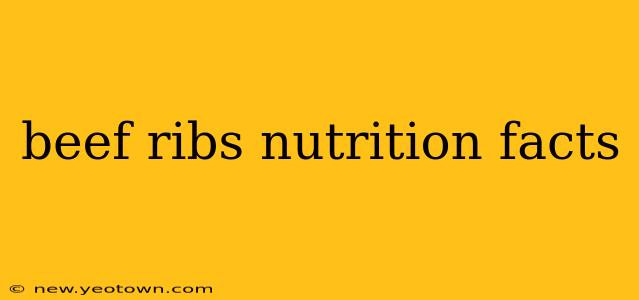Beef ribs, those succulent, fall-off-the-bone delights, are a favorite for backyard barbecues and special occasions. But beyond their mouthwatering taste, what’s the nutritional profile of these hearty cuts? Let's explore the nutritional facts of beef ribs, addressing some common questions along the way.
What are the nutritional benefits of beef ribs?
Beef ribs, like other cuts of beef, are a good source of protein, essential for building and repairing tissues. They also contain various vitamins and minerals, though the exact amounts vary based on the cut, preparation method, and marbling. A typical serving provides a significant dose of iron, crucial for red blood cell production and oxygen transport throughout the body. B vitamins, important for energy metabolism, are also present. However, it's important to note that the nutritional value can be impacted by cooking methods – adding excessive fat or sugar during preparation can significantly alter the final nutrient profile.
How many calories are in beef ribs?
The calorie count in beef ribs is notably higher than many other protein sources. A typical 3-ounce serving of beef ribs can contain anywhere from 200 to 350 calories, and this number can increase dramatically depending on the amount of fat and the cooking method. Factors like marbling (the fat interspersed within the meat), the cooking technique (grilling versus slow-cooking), and the size of the portion will all influence the final calorie count. Therefore, while satisfying, beef ribs should be enjoyed in moderation as part of a balanced diet.
Are beef ribs healthy?
The healthfulness of beef ribs, like any food, depends on context. They are a rich source of protein and certain micronutrients. However, their high fat and calorie content mean they are best consumed in moderation as part of a balanced diet. Regular consumption of high-fat meats can contribute to weight gain and an increased risk of heart disease if not balanced with other healthy choices. It’s crucial to consider the overall dietary pattern rather than focusing on individual foods in isolation.
How much protein is in beef ribs?
Beef ribs are an excellent source of protein, providing a significant contribution to your daily protein intake. A 3-ounce serving can contain approximately 20-30 grams of protein, depending on the specific cut and preparation. This high protein content makes them a great choice for athletes, individuals aiming to build muscle mass, and anyone needing a protein boost. However, remember that protein alone isn't the entire story; a balanced diet with plenty of fruits, vegetables, and whole grains is crucial for overall well-being.
What are the downsides of eating beef ribs?
The primary downside of eating beef ribs is their high fat and calorie content. This can contribute to weight gain if not balanced with other dietary choices and regular physical activity. Moreover, the high saturated fat content raises concerns about potential cardiovascular risks. While a special occasion indulgence isn't necessarily harmful, regular and excessive consumption should be approached with caution.
Conclusion: Enjoying Beef Ribs Responsibly
Beef ribs offer a delicious and satisfying culinary experience, delivering significant protein and some essential nutrients. However, their high fat and calorie content necessitate mindful consumption. Enjoying beef ribs as an occasional treat rather than a staple food, combined with a balanced diet and active lifestyle, allows you to savor this flavorful cut without compromising your overall health. Remember to choose leaner cuts when possible and employ cooking methods that minimize added fats and sugars. By making informed choices, you can enjoy the rich flavors of beef ribs while maintaining a healthy and balanced dietary approach.

